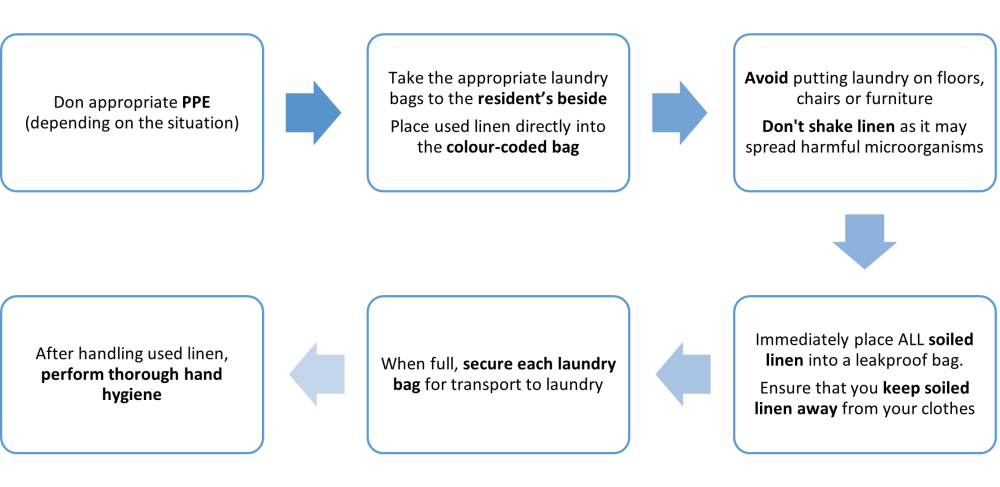Dirty Laundry Work Flow
It is essential to handle soiled and infectious linen appropriately and correctly. Used linen is potentially contaminated, so always ensure storage and handling of dirty linen minimises the risk of cross-contamination between clean and dirty items.
Separate items before transferring them to the laundry for efficient and correct processing. From the moment linen is collected, good hygiene is vital.
Procedure For Handling Dirty Linen and Clothing
The laundry uses a colour-coded system to segregate different types of laundry materials. Colour-coding makes it easier to identify items at risk of causing infection and reduces the risk of spreading an infection to employees and residents.
Soiled linen must always be carefully separated into appropriate linen skips, which have colour-coded bags and are opened with pedals.
|
Colour Code |
Area of Use |
|---|---|
|
Red |
Contaminated |
|
Yellow |
Infectious and Foul |
|
Green |
Kitchen Linen |
|
Blue |
Special Items |
|
Purple |
Cytotoxic |
|
White |
General Linen |
Contaminated linen = linen contaminated by blood, urine, or other body fluids.
Collecting Laundry
While handling dirty linen and clothing, wear appropriate personal protective equipment (PPE). Follow basic steps to handle used and soiled linen safely.

Transporting
Transport soiled linen and clothing safely to the dirty storage area of the laundry
Avoid personal injury by correct bag loading and removal of soiled bags
Transport soiled laundry from the resident area with designated collection trolleys
When laundry bags are 3/4 full, remove bags from the collection trolleys and place them in rising-base skips
Transport soiled collection bags in the rising-base skips directly to the soiled storage area of the laundry
Handle soiled linen bags carefully to avoid damage or the release of contaminants
When picking up full linen bags, hold the bag with both hands, keep feet facing in the direction the bag is being moved to, ensure a good hold on the bag, bend your knees as you lift and keep back straight
Do not place bags behind the door, as this will prevent the door from opening to the soiled storage area
Sorting
No additional sorting of soiled linen should be done at the collection point
The soiled laundry bags should be wheeled in a rising-base skip to the front of the washer with the top facing the washer, and items should be taken directly from the bag and placed into the washer
If pre-sorting has not occurred at the collection point, then sorting should be carried out in the soiled storage area only
Open linen bags one at a time for processing
Heavily soiled items should be processed as soon as possible, subject to linen requirements within the residential aged care facility
Only soiled linen is to be transported in soiled linen skips, appropriately marked for easy identification
All soiled linen sorting skips should contain self-levelling inserts that are in good operational order
Transfer the soiled skip to the washroom after sorting
Sort soiled linen for the next load
Loading and Washing
Do not sort foul or infectious laundry if received in plastic semi-permeable bags (alginate bags) or plastic bags identifying linen as infectious (hazardous bags)
Alginate and hazardous laundry should be priority processed and washed separately
Do not stack linen bags on alginate bags when handling foul or infectious laundry, as this may cause the seams to split
Wet and soiled linen should be processed as quickly as possible to avoid the development of microorganisms
Place the soiled sorting bin directly in front of the washer, then load
When loading/unloading, alternate operating sides to reduce the continual use of the same muscles
Do not mix laundry types (process similar items only)
Load from the front of the trolley to the rear
Allow one hand span space above the loaded laundry in the machine (i.e., a basic guide for loading is to place a fist between the top of the washer drum and the top of the laundry)
After emptying a bag of soiled laundry in a washer, place the laundry bag into the same wash load
Close the door securely
Select the correct chemical cycle for laundry classification
Select the correct wash cycle for laundry classification
Wipe the external surface of the door with neutral detergent
Once washed appropriately, handle linen no more than four times between the end of the wash cycle and the time it is stored in delivery skips
Keep all clean laundry (wet or dry) within the designated clean area of the laundry
Only unload clean laundry into specifically clean laundry skips or portable tables
Unload the washer and remove plastic items or anything that cannot be put in a dryer
When handling clean laundry, don a clean apron and gloves
Open the dryer door fully and place a portable folding table in front of the dryer door opening
Load from the front of the trolley to the rear
Load one full load from the correct washer only (choose the appropriate trolley matched to the dryer capacity)
Do not split loads or add loads
Ensure no loose laundry is caught around the door
Check and clean the lint filter when the dryer is non-operational, to the manufacturer's specifications (generally, lint requires removing a minimum of twice per day)
Close the lint compartment securely
Select the correct dryer program for linen classification (i.e., red, orange, or blue)